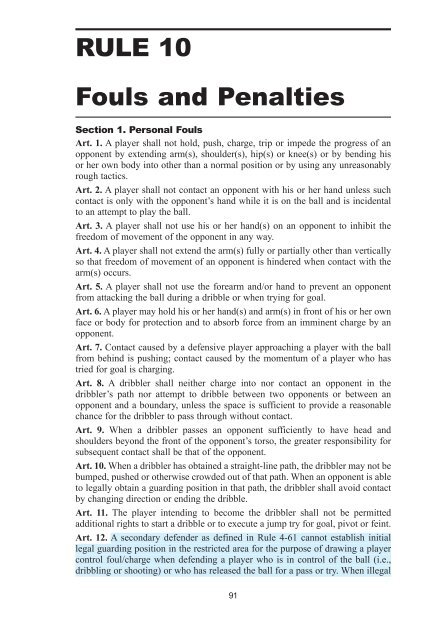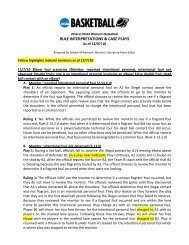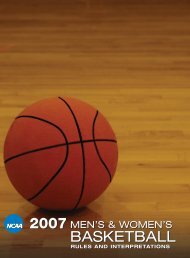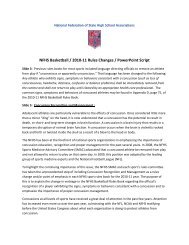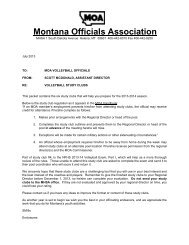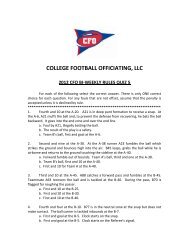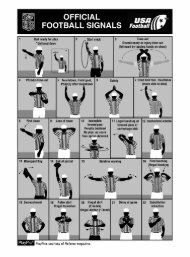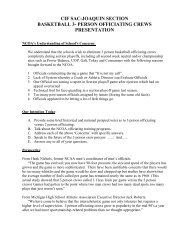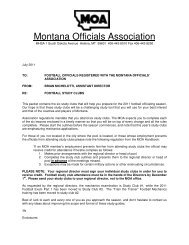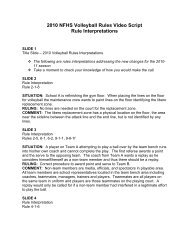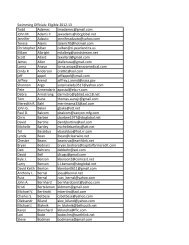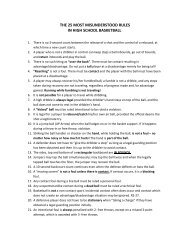2011-12 AND 2012-13 MEN'S AND WOMEN'S RULES - NAIA
2011-12 AND 2012-13 MEN'S AND WOMEN'S RULES - NAIA
2011-12 AND 2012-13 MEN'S AND WOMEN'S RULES - NAIA
Create successful ePaper yourself
Turn your PDF publications into a flip-book with our unique Google optimized e-Paper software.
RULE 10<br />
Fouls and Penalties<br />
Section 1. Personal Fouls<br />
Art. 1. A player shall not hold, push, charge, trip or impede the progress of an<br />
opponent by extending arm(s), shoulder(s), hip(s) or knee(s) or by bending his<br />
or her own body into other than a normal position or by using any unreasonably<br />
rough tactics.<br />
Art. 2. A player shall not contact an opponent with his or her hand unless such<br />
contact is only with the opponent’s hand while it is on the ball and is incidental<br />
to an attempt to play the ball.<br />
Art. 3. A player shall not use his or her hand(s) on an opponent to inhibit the<br />
freedom of movement of the opponent in any way.<br />
Art. 4. A player shall not extend the arm(s) fully or partially other than vertically<br />
so that freedom of movement of an opponent is hindered when contact with the<br />
arm(s) occurs.<br />
Art. 5. A player shall not use the forearm and/or hand to prevent an opponent<br />
from attacking the ball during a dribble or when trying for goal.<br />
Art. 6. A player may hold his or her hand(s) and arm(s) in front of his or her own<br />
face or body for protection and to absorb force from an imminent charge by an<br />
opponent.<br />
Art. 7. Contact caused by a defensive player approaching a player with the ball<br />
from behind is pushing; contact caused by the momentum of a player who has<br />
tried for goal is charging.<br />
Art. 8. A dribbler shall neither charge into nor contact an opponent in the<br />
dribbler’s path nor attempt to dribble between two opponents or between an<br />
opponent and a boundary, unless the space is sufficient to provide a reasonable<br />
chance for the dribbler to pass through without contact.<br />
Art. 9. When a dribbler passes an opponent sufficiently to have head and<br />
shoulders beyond the front of the opponent’s torso, the greater responsibility for<br />
subsequent contact shall be that of the opponent.<br />
Art. 10. When a dribbler has obtained a straight-line path, the dribbler may not be<br />
bumped, pushed or otherwise crowded out of that path. When an opponent is able<br />
to legally obtain a guarding position in that path, the dribbler shall avoid contact<br />
by changing direction or ending the dribble.<br />
Art. 11. The player intending to become the dribbler shall not be permitted<br />
additional rights to start a dribble or to execute a jump try for goal, pivot or feint.<br />
Art. <strong>12</strong>. A secondary defender as defined in Rule 4-61 cannot establish initial<br />
legal guarding position in the restricted area for the purpose of drawing a player<br />
control foul/charge when defending a player who is in control of the ball (i.e.,<br />
dribbling or shooting) or who has released the ball for a pass or try. When illegal<br />
91


